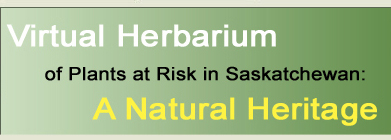|
| Viola septentrionalis Greene |
|
| * Viola septentrionalis
and Viola sororia are now considered by several authorities
to be the same species. |
|
| |
| TAXONOMY |
| |
| Family: |
Violaceae |
| Genus: |
Viola |
| |
| Species Synonyms: |
none |
| Common Names: |
northern woodland violet
northern blue violet |
| |
| DISTRIBUTION |
| |
| Canada: |
southern British Columbia, east-central Saskatchewan,
Ontario – Quebec – New Brunswick – Newfoundland –
Nova Scotia |
| Saskatchewan: |
east-central Saskatchewan; Carragana – Usherville
|
| Ecoregion: |
Boreal Transition, Mid-Boreal Upland |
| |
| HABITAT |
| |
| Saskatchewan: |
open white spruce-aspen mixed woods |
| |
| RARITY STATUS |
| |
Provincial
Status According
to Harms (2003): |
Threatened |
| Nature Conservancy
Status: |
G5 |
Saskatchewan
Species at
Risk Status: |
None |
| COSEWIC Status:
|
None |
| |
| Northern woodland
violet is threatened because of extreme rarity in Saskatchewan.
This species has only been located in one small region of the province and
is usually locally sparse. |
| |
| SPECIES
DESCRIPTION |
| |
| Rhizomes: |
thick, fleshy |
| Stems: |
leafy stem absent; woody base frequently branching;
runners absent |
| Leaves: |
basal, stalks sparsely hairy, blades 2 –
3 cm wide, oval to kidney-shaped, base distinctly heart-shaped, tip obtuse
to acute, sparsely hairy, margin uniformly toothed |
| Inflorescence: |
flowers solitary; stalks usually shorter than
to equalling leaves; self-fertilizing flowers on ascending or erect stalks |
| Flowers: |
perfect, irregular; sepals 5, lance-shaped to
oval, margins long-hairy nearly to tip, ear-like lobes at base divergent
and conspicuous; petals 5, spurred and lateral petals subequal, all petals
bearded at base, spur blunt, deep violet to purple; stamens 5; ovary superior |
| Fruits: |
capsule 3-valved, yellowish, hairless |
| |
| VIOLA
KEY FOR SPECIES FOUND IN SASKATCHEWAN |
| |
| 1 Plants without leafy stems; leaves
and flower stalks arising from a woody base and/or plants with runners |
2 |
| 1 Plants with leafy stems; flowers
axillary, runners and woody bases absent |
11 |
| |
|
| 2 Leaves deeply divided; plants of
prairies and dry areas |
V. pedatifida |
| 2 Leaves toothed or lobed but not
deeply divided or margin entire; plants of meadows to moist woods or boggy
areas |
3 |
| |
|
| 3 Flowers white, may have purplish
lines towards the base |
4 |
| 3 Flowers blue to violet |
7 |
| |
|
| 4 Plants without runners; leaves circular
to kidney-shaped |
V. renifolia |
| 4 Plants with runners; leaves oval
to kidney-shaped |
5 |
| |
|
| 5 Leaves hairy, at least when young;
leaf and flower stalks reddish |
V. blanda var. palustriformis |
| 5 Leaves hairless; leaf and flower
stalks greenish |
6 |
| |
|
| 6 Leaves 2 – 5 cm long, 2.5
– 3.5 cm wide |
V. palustris var. brevipes |
| 6 Leaves 1 – 2 cm long, 1 –
1.5 cm wide |
V. macloskeyi ssp. pallens |
| |
|
| 7 Rhizomes thick and fleshy; runners
absent; woody base usually short and thick; lateral petals bearded or not;
sepals with or without marginal hairs |
8 |
| 7 Rhizome slender and cord-like; runners
present or absent; woody base present or absent; lateral petals always bearded
(except V. selkirkii); sepals without marginal hairs |
10 |
| |
|
| 8 Spurred petal beardless |
V. sororia |
| 8 Spurred petal bearded |
9 |
| |
|
| 9 Sepals with marginal hairs |
V. septentrionalis |
| 9 Sepals without marginal hairs |
V. nephrophylla |
| |
|
| 10 Runners present; petal spur much
shorter than the blade; lateral petals bearded; plants of moist meadows
and streams |
V. palustris var. palustris |
| 10 Runners absent; petal spur to 2/3
as long as blade; lateral petals beardless; plants of woods and rocky slopes |
V. selkirkii |
| |
|
| 11 Leaves lance-shaped to narrowly
oval; flowers yellow, may have purple veins at the base |
12 |
| 11 Leaves heart-shaped to kidney-shaped;
flowers yellow, white or blue |
13 |
| |
|
| 12 Leaves usually at least three times
as long as wide, lance-shaped to elliptic |
V. nuttallii |
| 12 Leaves less than three times as
long as wide, narrowly oval |
V. vallicola var. vallicola |
| |
|
| 13 Flowers yellow, with purplish-brown
veins; plants of rich deciduous woods |
V. pubescens var. scabriuscula |
| 13 Flowers white to lilac or blue;
plants of woods or meadows |
14 |
| |
|
| 14 Flowers white inside, yellow at
base and with purplish veins or purple tinge on outside; stipules entire |
V. canadensis var. rugulosa |
| 14 Flowers blue to lilac; stipules
toothed |
15 |
| |
|
| 15 Leaves thin, hairless; stipules
oval; flowers lilac |
V. conspersa |
| 15 Leaves thick, glabrous to densely
pubescent; stipules linear; flowers deep blue |
16 |
| |
|
| 16 Leaves densely hairy |
V. adunca var. adunca |
| 16 Leaves hairless |
V. labradorica |
|






